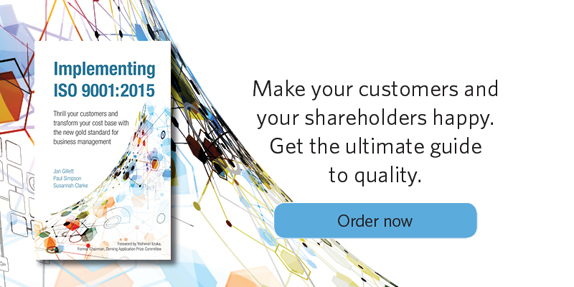The Process Approach – everything should be made as simple as possible, but no simpler
26 January 2016 by Catherine Holdsworth in Business and finance, Implementing ISO 9001:2015
Paul Simpson, co-author of Implementing ISO 9001:2015 looks into how applying the Process Approach can make reregistering for ISO 9001:2015 easier than you think.
It’s highly likely that many of us seeking improvement in effectiveness and efficiency of the way our work functions see process analysis and mapping done well as part of the solution. However, when done badly they can get in the way.
We’ve probably all seen the extremes – on the one hand perhaps a wall full of mind-sapping detail, on the other a series of banal boxes neither helping staff and leaders. So this quote, ‘Everything should be made simple as possible, but no simpler‘ attributed to Albert Einstein, is a useful stimulus in thinking about making process analysis useful, and to help ISO 9001:2015 registration.
 The point of analysing our processes is to ensure we understand how each process works and what we need to do as individuals, leaders and organisations to ensure the process operates efficiently and delivers effectively. So that’s it – simple! We sit down flowchart the process step back and say ‘Abracadabra’ and we’ve stepped into a state of Nirvana through the Process Approach. If only it were so.
The point of analysing our processes is to ensure we understand how each process works and what we need to do as individuals, leaders and organisations to ensure the process operates efficiently and delivers effectively. So that’s it – simple! We sit down flowchart the process step back and say ‘Abracadabra’ and we’ve stepped into a state of Nirvana through the Process Approach. If only it were so.
Let’s take a step back from the quote and do some digging:
- The published quote from Einstein that comes closest to ‘our’ subtitle is: ‘It can scarcely be denied that the supreme goal of all theory is to make the irreducible basic elements as simple and as few as possible without having to surrender the adequate representation of a single datum of experience.’Now apart from being a lot less easy to read and understand this more complex quote covers a lot more ground and options that we will address later.
- How this came to be attributed to Einstein is through an article in the New York Times by the composer Roger Sessions where he says: ‘I also remember a remark of Albert Einstein, which certainly applies to music. He said, in effect, that everything should be as simple as it can be but not simpler!’
So please forgive me as I translate the Einstein quote into a summary we can apply to our process analysis as we look to make transition to ISO 9001:2015 certification:
We have to break each process down into as few simple steps as possible based on our experience of how they work in real life. And we must ensure that we understand their relationships and contribution to the other processes in the overall system in generating outputs for the customer.
So for each process step, we need a more profound understanding of the activity than just to type a simple flowchart box description.
Taking an everyday example: most manufacturing processes and many service deliveries have a final flowchart box: ‘Deliver goods / Drive to service delivery point’ – Abracadabra again!
Again, if only it were that simple. Most blog readers have real world experience of driving. In the UK where I drive most, it is notoriously unpredictable and the same applies for every national capital and many trunk roads in most countries around the globe. If we are to truly understand the process approach we need to spend time and effort on that one box on our flowchart ‘Deliver goods’.
Here is a short list I came up with that frame the activity:
- Delivery instructions
- Available vehicle
- Loading arrangements
- Distance to customer
- Available driver
- Traffic situation
- Accidents
- Weather conditions
- Customer security procedures
- Unloading arrangements
The process approach says you have a good understanding of each activity element and can control them to satisfy your customer.
Drilling down into a couple then:
Available driver
- Licence to drive vehicle class?
- Competent to act as your organisation representative out on the road?
- Current clean licence?
- Time on tachograph to complete planned job?
Contingency for:
- Peaks in demand?
- Holiday / sickness absence?
- Traffic situation
- At departure time?
- At planned return time?
- Roadworks on the primary route?
- Alternative routes in the event of a disruption?
- Major events (sporting / social) along planned route(s)?
- Unusual expected traffic pattern (holiday periods)?
In order to demonstrate they have ‘determined’ their processes (under the requirements of ISO 9001:2015 Clause 4.4.1) organisations need to answer all bullets above (and a lot more I haven’t thought of). Many answers won’t come from the same area the driver is in but may be carried out by individuals working in other processes: recruitment / licence checking (perhaps in HR), or traffic monitoring (in a central logistics function) for example. So our organisational complexity builds and we have a range of support processes influencing our ability to ‘Deliver’ – a single box in one order fulfilment process. Obviously, this is now a lot of work but it does have a purpose: By understanding our process better we are able to improve it and cope with eventualities as and when they happen.
When we have done this we will have taken our ISO 9001 quality management system from a ‘thin skim’ document to an efficient, resilient way of working and we will have satisfied quality management principle 4 – Process Approach: ‘Consistent and predictable results are achieved more effectively and efficiently when activities are understood and managed as interrelated processes that function as a coherent system.’

